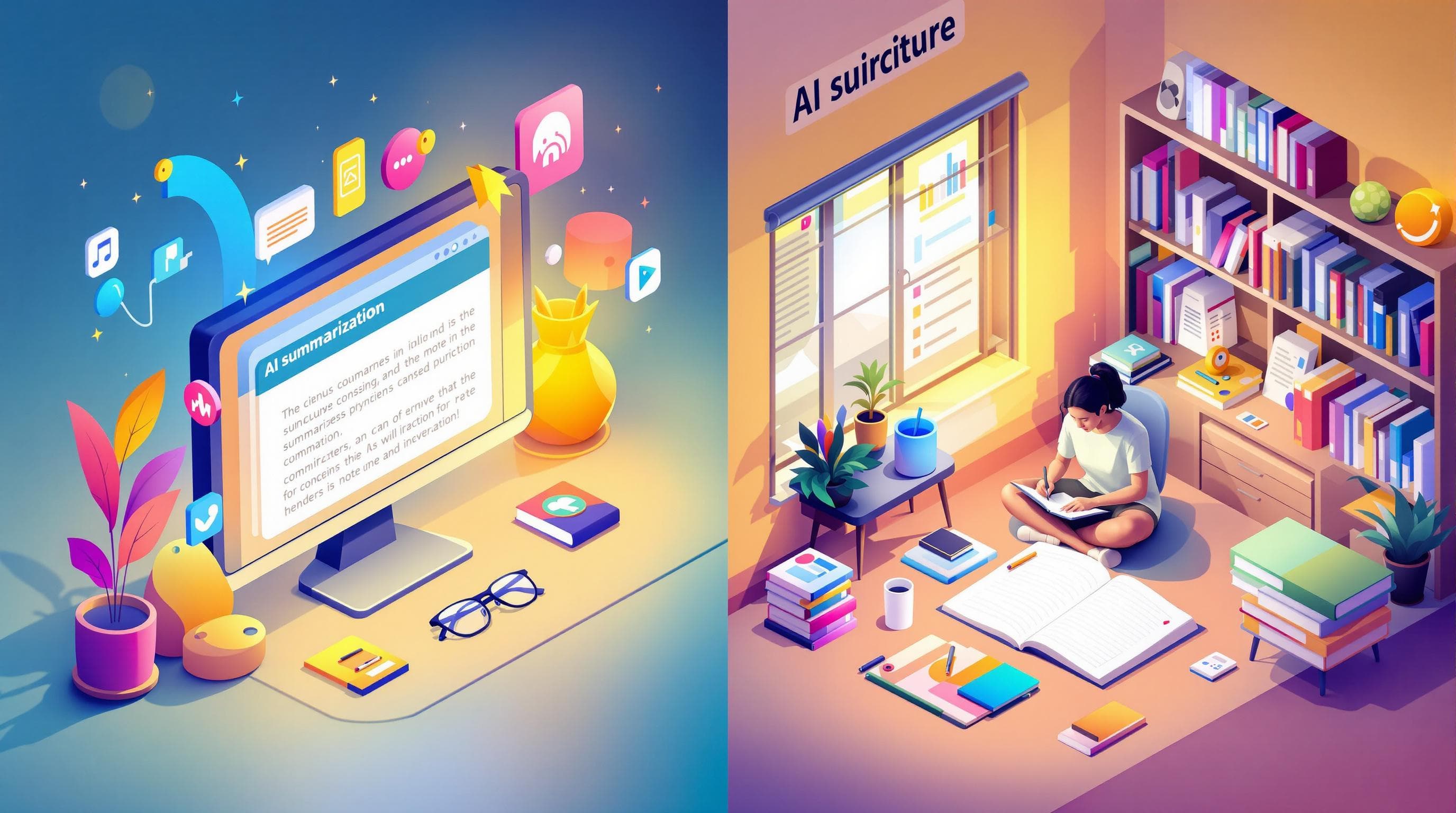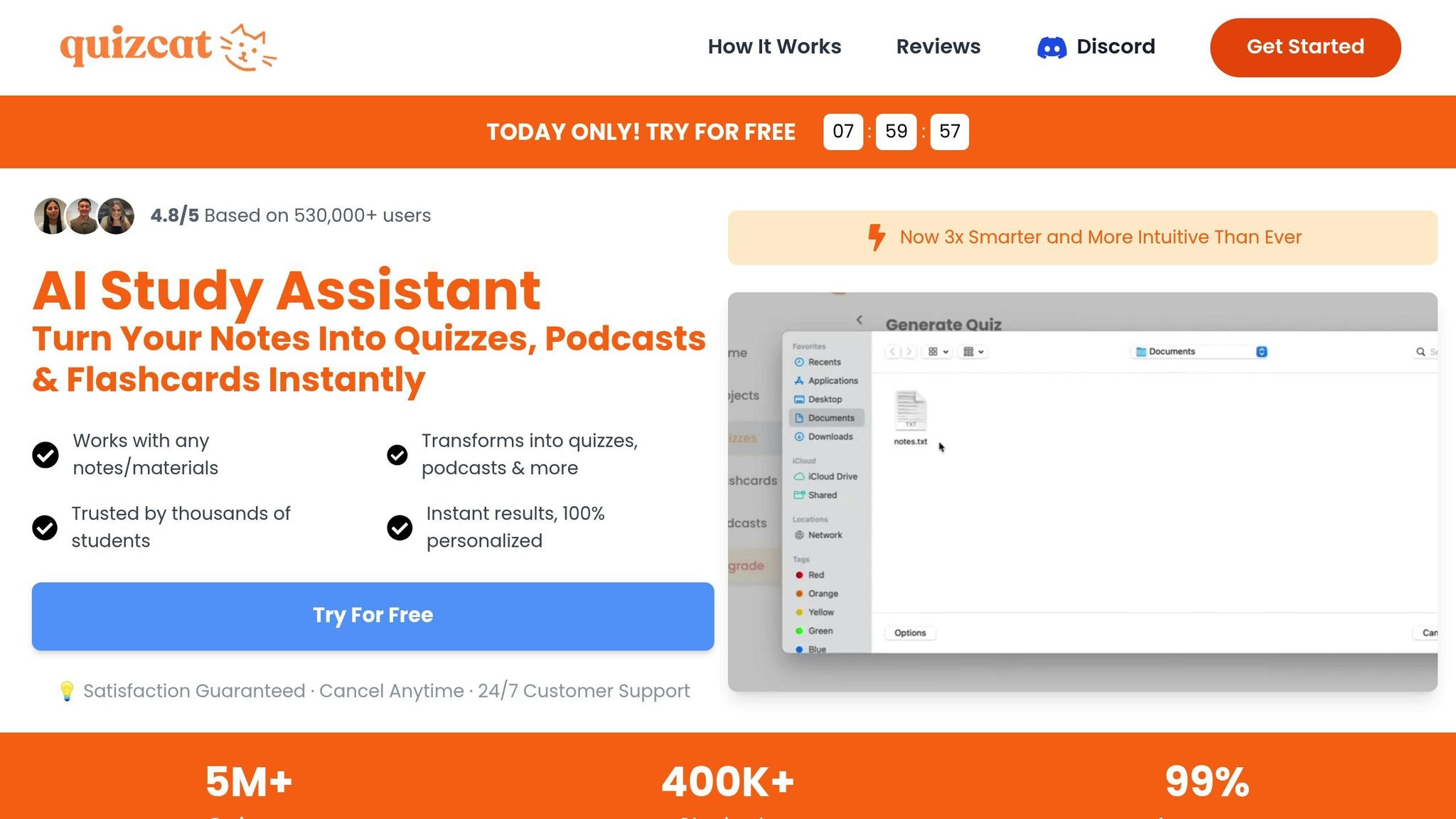
AI Summarization vs. Manual Note-Taking: Key Differences
AI summarization tools and manual note-taking serve different purposes, and understanding their strengths can help you study more effectively. Here's a quick breakdown:
- AI Summarization: Fast, efficient, and ideal for converting large volumes of information into study tools like flashcards, quizzes, and even podcasts. AI saves time and helps with quick review but may miss subtle details or context.
- Manual Note-Taking: Slower but better for understanding and retaining complex material. Writing by hand engages your brain, preserves context, and reinforces memory, making it great for in-depth learning.
Quick Comparison
| Feature | AI Summarization | Manual Note-Taking |
|---|---|---|
| Speed | Processes notes in seconds | Takes hours to write and organize |
| Formats | Creates quizzes, flashcards, podcasts | Single format, requires manual effort |
| Accuracy | High accuracy but may lack context | Captures subtle details and context |
| Memory Retention | Less engagement, relies on review tools | Boosts memory through active writing |
| Best For | Fast-paced lectures, quick preparation | Complex concepts, deeper understanding |
For the best results, combine both methods: take handwritten notes for better comprehension and use AI tools to streamline review and study time.
Can This AI Recorder Replace Manual Notes?
Speed and Time Management
AI summarization and manual note-taking differ greatly when it comes to speed and efficiency. Feedback from over 530,000 users highlights how AI tools are changing how students handle their study time and absorb information.
AI Speed Advantages
AI tools are incredibly fast at turning lecture notes into various study formats. User data shows that these tools can create ready-to-use materials in seconds, compared to the hours students often spend organizing notes manually.
"This tool just gets it. I was spending hours making flashcards before, but now I upload my notes, and everything's done in seconds. Total game-changer." - Ryan Kim
Even with these benefits, manual note-taking is still common in fast-paced lectures, despite its slower pace.
Challenges with Manual Note-Taking
Unlike AI, traditional note-taking often struggles to keep up in quick-moving environments. Writing by hand can lead to incomplete notes, especially when information is delivered rapidly.
| Aspect | Manual Notes | AI Processing |
|---|---|---|
| Processing Time | Hours | Seconds |
| Format Generation | Single format | Multiple formats at once |
| Live Capture | Limited by writing speed | Captures everything |
| Organization Time | Additional time needed | Instantly organized |
The slower process of manual note-taking can make it tough to keep up with fast lectures. By saving time with AI, students can shift their focus to understanding and mastering the material.
Information Quality
The way information is captured through AI summarization versus manual note-taking differs significantly in terms of accuracy and depth. Data from over 530,000 users highlights some key trends in how these methods handle lecture content.
AI Summary Quality
AI tools are excellent at generating detailed, searchable summaries that can be adapted into different study formats. They process and organize information quickly and with high accuracy, as reflected in user feedback.
"The quizzes it makes from my notes are so spot-on. My test scores have gone up, and I actually enjoy studying now." – Sophia Martinez
| Aspect | AI Summary Strengths | AI Summary Limitations |
|---|---|---|
| Detail Capture | Captures key points effectively | May miss subtle contextual details |
| Format Flexibility | Offers multiple study formats | Lacks emotional understanding |
| Searchability | Instant keyword search | Can miss nuanced meanings |
| Organization | Automatically categorizes content | May require manual adjustments |
AI's advantage lies in its ability to handle large amounts of information quickly while maintaining a high degree of accuracy.
Manual Note Quality
On the other hand, manual note-taking offers unique benefits that AI tools can't replicate. Writing notes by hand helps students engage more deeply with the material and retain context, especially in complex subjects where subtle details matter.
Manual note-taking stands out in several areas:
- Deeper Understanding: Writing encourages active engagement with the material.
- Context Preservation: Captures subtle meanings and relationships within the content.
- Personal Organization: Notes are structured in a way that aligns with the note-taker's thought process.
- Memory Boost: The act of writing helps reinforce memory retention.
While manual note-taking can be challenging during fast-paced lectures, its ability to preserve context and support personal learning makes it a valuable tool for many students. Each method has its strengths, catering to different study needs and preferences.
sbb-itb-1e479da
Learning Impact
AI summarization and manual note-taking influence how students retain information in distinct ways, as demonstrated by data from over 530,000 users.
AI Learning Effects
AI-powered tools have changed the way students engage with study materials by turning notes into various formats like flashcards, quizzes, and even podcasts. These options keep learning interactive and engaging. For example:
"Uploading my notes and instantly having quizzes ready feels like magic. This tool has completely changed the way I study. I actually feel prepared for once!" - Maya Johnson
The podcast feature stands out for its convenience:
"The flashcards are crazy good, but the podcast feature is my fave. It reads my notes back to me while I'm at the gym or driving. Talk about multitasking!" - Ethan Blake
Manual Note Learning Effects
In contrast, manual note-taking offers a hands-on method that strengthens cognitive connections. Writing by hand engages multiple senses, which helps with memory and recall. This approach often leads to a deeper understanding of concepts, better retention through muscle memory, clearer organization of ideas, and improved focus during lectures.
Combining both methods often delivers the best results. Manual note-taking lays a solid groundwork for understanding, while AI tools make the review process more efficient, enhancing overall learning outcomes.
Sharing and Access
Sharing and accessing study materials effectively can make a huge difference in how students collaborate and learn. Thanks to digital tools, educational content can now be shared and accessed instantly.
AI Sharing Features
AI-powered tools have changed the game for sharing and accessing notes. For example, QuizCat AI has over 400,000 users, showing how popular these tools have become. These platforms make it easy to share content across devices in seconds.
"I was drowning in notes before I found this tool. Now, it turns everything into flashcards, quizzes, and even podcasts! Studying has never been this easy. Highly recommend!"
– Emily Carter, QuizCat AI User
Key features that students love include:
| Feature | Benefit |
|---|---|
| Cross-device Access | Study materials available on any device |
| Multi-format Conversion | Notes transform into quizzes, flashcards, and podcasts |
| Instant Distribution | Share with classmates immediately |
| Cloud Storage | Access notes anytime, anywhere |
These tools not only make individual studying easier but also improve group learning. Traditional methods just can't keep up.
Challenges with Manual Note Sharing
Manual note sharing has its own set of drawbacks. Handwritten notes, for instance, come with several limitations:
- Physical restrictions: Hard to copy or share.
- Legibility issues: Handwriting can be unclear.
- Format limitations: Difficult to convert into other formats.
- Access problems: Requires being physically present.
"Why didn't I know about this sooner? I can listen to my notes like a podcast on the bus - so convenient! My friends are all using it now too."
– Olivia Brooks, QuizCat AI User
These differences highlight how study tools have evolved, making learning more accessible and collaborative than ever before.
Best Uses for Each Method
Here’s how to decide which method works best for your study needs:
When to Use AI
AI summarization shines in situations that demand speed and efficiency:
| Scenario | Why It Works |
|---|---|
| Fast-paced Lectures | Quickly captures and organizes rapid information. |
| Content Review | Turns your notes into ready-to-use study tools. |
| Multi-format Learning | Creates quizzes, flashcards, or even podcasts. |
| Time-sensitive Prep | Instantly generates materials for upcoming exams. |
"Uploading my notes and instantly having quizzes ready feels like magic. This tool has completely changed the way I study. I actually feel prepared for once!" – Maya Johnson
AI is perfect for quick preparation and converting notes into various formats. However, for deeper learning, traditional methods still have their place.
When to Take Manual Notes
Manual note-taking is better suited for more detailed and hands-on learning:
| Scenario | Why It’s Better |
|---|---|
| Complex Concepts | Allows for diagrams and detailed annotations. |
| Mathematical Work | Helps with writing formulas and solving problems. |
| Creative Thinking | Encourages drawing mind maps and linking ideas. |
| Initial Learning | Boosts focus and understanding of new material. |
Writing notes by hand reinforces comprehension and works best when tackling new or intricate subjects.
"Was stuck in the 'write notes but never review them' cycle. This AI saved me. It's all done for me now - flashcards, quizzes, everything! 🤯" – Alex Rivera
The key is knowing when to use each approach to match your study goals effectively.
Conclusion
The best study strategies combine manual note-taking for deeper comprehension with AI tools for quicker and more efficient review. Writing notes by hand helps with understanding and mastering complex ideas, while AI tools can turn those notes into powerful study aids.
To get the most out of your study sessions, take handwritten notes during lectures to stay engaged, then digitize them for easier and more thorough review. This blend of methods forms the foundation of what QuizCat AI offers.
QuizCat AI Features

QuizCat AI takes these approaches to the next level by combining the strengths of manual note-taking with the convenience of AI. Here's what it brings to the table:
| Feature | What It Does |
|---|---|
| Smart Quiz Generation | Instantly creates tailored quizzes |
| Interactive Flashcards | Turns key concepts into easy-to-review cards |
| Audio Learning | Converts your notes into podcasts for on-the-go studying |
| Multi-format Support | Compatible with PDF, DOCX, and TXT files |
With an impressive 4.8/5 rating from over 530,000 users, QuizCat AI has proven to improve study efficiency. By pairing the depth of manual note-taking with the speed of AI-powered review, it helps students achieve better results.
Ready to upgrade your study routine? Start using QuizCat AI this week for just $0.99.
